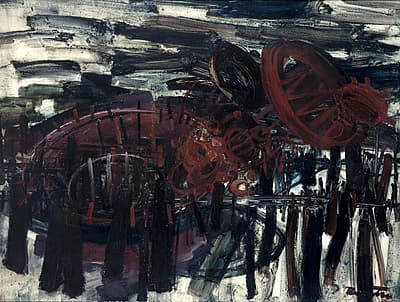
Stanislaus
RAPOTEC
Italy
1913
–
Australia
1997
Yugoslavia, Middle East 1918-48;
Australia from 1948; France, Italy 1972- 78
Experience in the far west
1961
synthetic polymer paint on composition board
signed l.r., synthetic polymer paint "Rapotec". not dated
135.5 (h)
x 184.0 (w)
cm
Purchased 1963
National Gallery of Australia, Canberra
NGA 1963.23
- the artist;
- from whom bought by the Commonwealth Art Advisory Board, August 1963;
- transferred to the Australian National Gallery, July 1990
- I had a dream: Australian art in the 1960s
- National Gallery of Victoria 23 Apr 1997 – 16 Jun 1997
- Abstract Expressionism: the National Gallery of Australia celebrates the centenaries of Jackson Pollock and Morris Louis
- 14 Jul 2012 – 24 Feb 2013
- Stanislaus Rapotec, interview with James Gleeson, 22 October 1979, James Gleeson interviews, Australian National Gallery, 1977–1979, http://www.nga.gov.au/Research/Gleeson/pdf/Rapotec.pdf;
- Daniel Thomas, ‘Experience in the far West’, Anne Gray (ed.), Australian art in the National Gallery of Australia,Canberra: National Gallery of Australia 2002, illus. col. p. 251;
Stanislaus Rapotec’s works are tough, spontaneous and demanding. In his 2002 discussion of the large-scale painting Experience in the far West 1961, Daniel Thomas described Rapotec’s work as ‘explosive’ and ‘provocatively, pure abstract gestures from the subconscious’. Rapotec’s paintings are motivated by a personal and meditative approach to mark-making, which is inspired by memories of emigration, aspects of social and religious history, as well as his travels in Australia and abroad.
Experience in the far West is part of a body of work that draws on Rapotec’s experience of travelling through outback Australia, from the Flinders Ranges to semi-desert regions of New South Wales near Broken Hill. Back in his studio in Sydney, rather than literally painting the landscape, Rapotec worked with the sensations and memories of being in these environments, to create dynamic abstract compositions. In Experience in the far West , tones of black, grey, red and white are worked into a strong, concentrated arrangement of horizontal and vertical marks and bold orbital forms. While the background is bright white, it appears stained in places, where the dark overlays have bled into the lightness, this is a result of Rapotec’s preference for working with a very wet ground. He described his process as ‘flooding’ the work with a ground wash, to ensure the desired aesthetic outcome.
Hints of blues and greens also emerge between the darker colours. Rapotec never pre-selected his colours, preferring to dip spontaneously into a range of different tins with the same brush, ‘to get the sort of mixture which will come out through millions of little accidents when you are making your stroke’.[1] Rapotec worked rapidly with large, well-worn, second-hand, house-painting brushes, applying paint to horizontally positioned composition boards. From the mid 1950s he worked exclusively with synthetic polyvinyl acetate polymer paints, for their fluid and smooth drying qualities.
A self-taught painter, Rapotec’s strong grounding in art history was the result of significant independent research, including his time spent travelling through Europe and the Middle East. In the 1950s he was inspired by the contemporary work he had seen by European and American Abstract Expressionists, yet he noted the desire to push beyond these influences to create distinctive images: ‘all the time I was also trying to escape from established patterns there.’[2] Following his move to Sydney in 1955, Rapotec abandoned the figurative work that characterised his painting during the war, and before his arrival in Australia, and went on to establish the personal Abstract Expressionist practice which he continued throughout his career.
Miriam Kelly
[1] Rapotec interviewed by James Gleeson, 22 October 1979, James Gleeson interviews, Australian National Gallery, 1977–1979, transcript accessible through: http://www.nga.gov.au/Research/Gleeson/pdf/Rapotec.pdf
[2] Gleeson 1979
The National Gallery of Australia holds two works by Rapotec: Experience in the far West and a watercolour from 1957.
